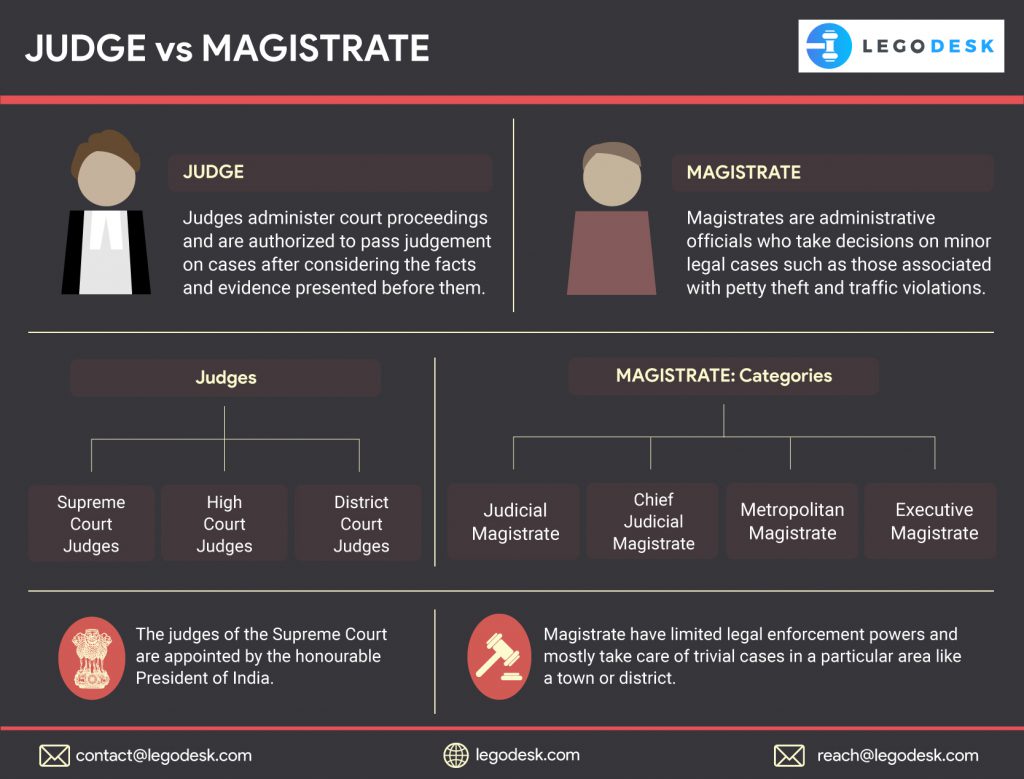Judge vs Magistrate: Major factors that differentiate them

Judiciary, the third and most important pillar holding the Indian democracy, is unique with its intricacies and may appear complex to an outsider with no knowledge of it. Such an instance occurs when talking about judges and magistrates.
Unlike the popular belief, the term “Judge” and “Magistrate” differ from each other in more than one aspect. Let’s get into them one by one.
Definition of “Judge”:
The etymology of the word “Judge” lies in the French word ‘Juger’ meaning to have an opinion on something. Judges are people who hold a legal degree and have worked as lawyers during their initial career years. They administer court proceedings and are authorized to pass judgment on cases after considering the facts and evidence presented before them.
Read Also – How Judges of Indian Court are appointed?
Depending on the office they hold, their jurisdiction, power, tenure, and functions vary. At times, there is a panel of judges to proceed over certain major cases. Recently, a Supreme Court Bench was assigned with the crucial task of ruling over the curative petition filed by 2012 Delhi Gang Rape convicts.
The judges of the Supreme Court are appointed by the honourable President of India. The Chief Justice of India holds their office till the age of retirement, i.e. until the age of 65 years. The President also appoints the judges of the subsequent High Courts after consulting the Chief Justice of India and the Governor of the respective states.
In the Indian judiciary, there are supreme court judges, high court judges, district court judges, and other subordinate judges who act together to enable the legal system to run smoothly.
Read Also – Salary of Judges In India
Definition of “Magistrate”:
On the other hand, magistrates are administrative officials who take decisions on minor legal cases such as those associated with petty theft and traffic violations. They have limited legal enforcement powers and mostly take care of trivial cases in a particular area like a town or district.
Magistrates can be further categorized as,
- Judicial Magistrate: They rest at the lowest level of the criminal judiciary system. It is the right of every accused to be presented before a Judicial Magistrate within 24 hours of the arrest. They are governed by the Session Judge and are subordinate to the Chief Judicial Magistrate. They can sentence a convict to prison for a maximum of 3 years and levy fines up to 10, 000 INR.
- Chief Judicial Magistrate: The CJM looks over the magistrates’ court and can sentence a prison sentence lasting up to 7 years. However, there is no maximum limit to the fine they can impose on a convict. A Chief Judicial Magistrate can report the misbehavior of a Judicial Magistrate to the High Court of the respective state. He or she is subordinate to the session judge.
- Metropolitan Magistrate: The magistrates appointed for metro cities (cities whose population exceeds the one million mark) are known as Metropolitan magistrates. In power and authority, they are similar to the Judicial Magistrates.
- Executive Magistrate: As per their name, they are the officer of the executive branch and thus cannot pass judgments on any matter. They are appointed under the discretion of the state government and hold the power to implement Section 144, making “unlawful assembly” effective.
In countries such as the US, judges appoint the magistrates under their jurisdiction. Notably, the term “Magistrate” is derived from the word “magister” meaning “administrator”. Magistrates of any level do not hold the power to sentence a convict into life imprisonment or the death sentence.

In unpopular opinion, a judicial officer who hears to civil cases (disputes between individuals or organizations) is known as a Judge. Whereas, a judicial officer presiding over criminal cases (cases harmful to the society and considered as against the jurisdiction or state) is termed as a Magistrate.
Salaries & Perks:
PUT THIS DATA IN AN INTERACTIVE TABLE FORMAT:
| Position | Salary (per month) in INR |
| Supreme Court | |
| Chief Justice of India | 2,80,000 |
| Other SC Judges | 2,50,000 |
| High Court | |
| Chief Justice | 2,50,000 |
| Other HC Judges | 2,40,000 |
| District Court | |
| Judicial Magistrate | 1,11,000 |
| Chief Judicial Magistrate | 1,44,000 |
| Executive Magistrate | 78,000 |
| Metropolitan Magistrate | 1,20,000 |
Perks associated with Judges:
- Rent-free/low-rent government house
- Security/Driver/Orderlies/Servants
- Official vehicle & allowance for petrol
- Telephone & Electricity allowance
- Medical Reimbursements
- Leave Travel Concession
- Free-ride across countrywide toll plazas
The magistrates also enjoy a few of these benefits such as that on housing, medical coverage, electricity, and telephone bills.
Conclusion:
Even though the roles, salaries, and perks of a judge and a magistrate may appear similar, they are very different at a fundamental level. The judiciary system of India, although intricate, makes sure justice prevails across the society and is easily accessible to the denizens through its legislative and executive wings.